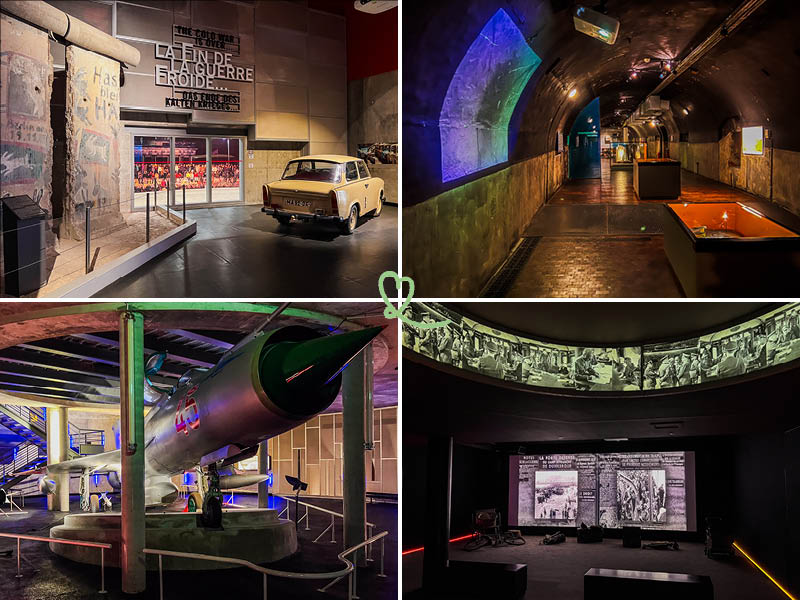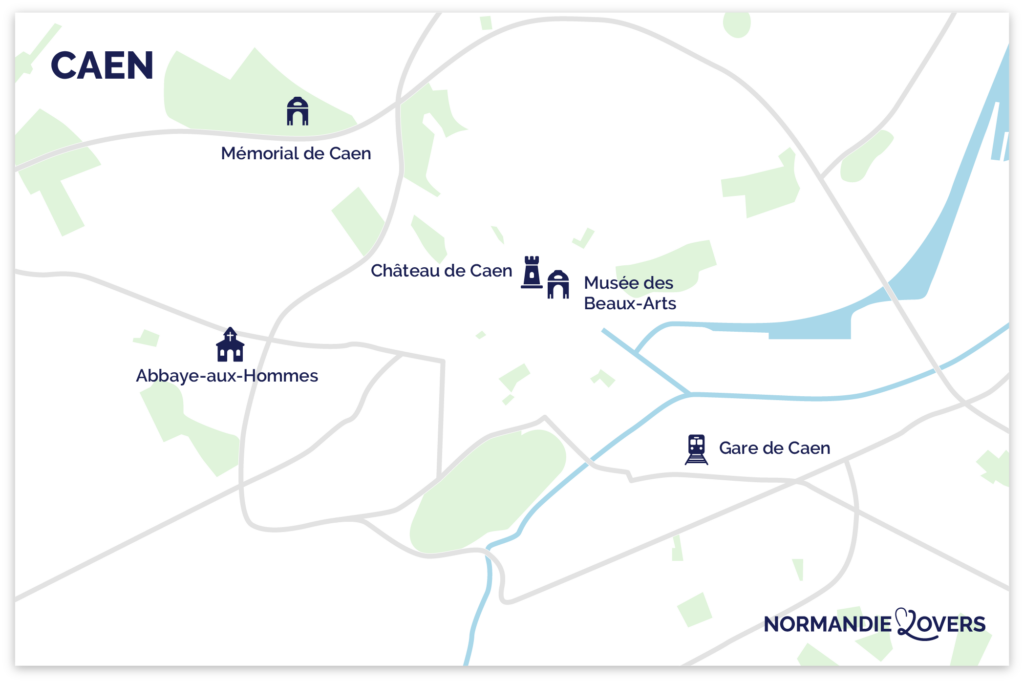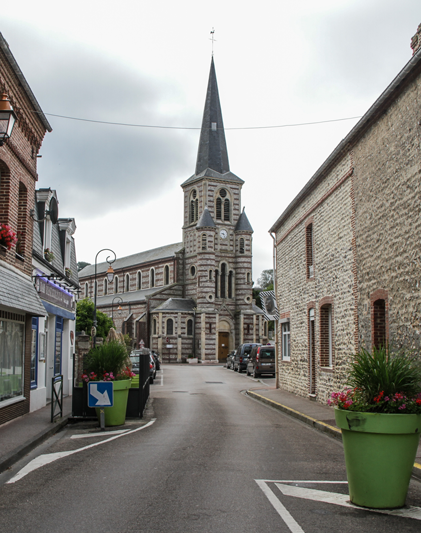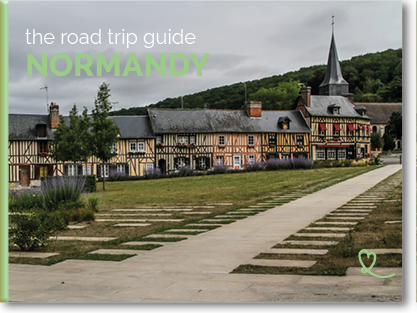Are you planning to visit the Memorial de Caen Museum? A must-see when visiting Normandy, we plunged into the heart of 20th-century history. We’ll never forget our visit to the museum, because we were captivated and educated!
Inaugurated in 1988 by François Mittérand, the memorial aims to promote peace and pay tribute to the victims of the Second World War. Thanks to interactive exhibits, historical documents and moving testimonials, you’ll gain a deeper understanding of this tragic period in world history.
In this article, we share our experience and photo tips for discovering the place and its many rooms.

This review is completely independent, we stayed anonymously and paid our bill in full.
Why visit the Memorial de Caen Museum?
Is the Caen Memorial worth a visit?
In our opinion, you must visit the memorial at least once in your life! The tumultuous history of the 20th century, and in particular that of the Second World War, is described in detail. The museum is packed with important information that we didn’t have access to in our history textbooks. What’s more, the memorial is highly interactive, as you can watch short films. We found the exhibits captivating and the period testimonies very moving.

As you explore the rooms, you’ll be able to grasp the scale of the suffering endured by the victims and heroes of this period. The museum promotes a universal message of peace and tolerance, encouraging deep reflection on the importance of preserving peace in today’s society. A visit that will leave a deep impression on you!
Book your ticket to the Caen Memorial now!
Why is theCaen Memorial famous?
An emblematic place of remembrance dedicated to the events of the Second World War and the promotion of peace, the museum is enormously popular. As an internationally renowned memorial, it attracts visitors from all over the world eager to understand the tragic consequences of war. Our experience at the museum made us think a lot about the need to preserve peace in today’s society. Its mission of commemoration and education makes it a powerful symbol for honoring the victims of war and promoting a more peaceful future. In fact, it’s included in our article on must-do activities in Caen.

What we liked best
During our visit to the memorial, we had a few favorite moments. We are aware that everyone’s sensibilities are different. Nevertheless, we’d like to share our 3 highlights with you:
- visit to the bunker: we explored the former underground command post of German General Wilhelm Richter. This historic site played a crucial role in the first decisive weeks of the Battle of Normandy.
- authentic aircraft: as soon as we entered the museum, we were greeted by a Howker Typhoon. Later, we gazed at a Soviet MIG 21 fighter plane. Impressive!
- historical newspapers: we loved discovering the front pages of period newspapers during our visit. They bear witness to the climate of terror during this period, but also to the explosion of joy at the moment of liberation!

Subscribe to our Newsletter
- Get away from it all with Region Lovers’ beautiful destinations!
- Once a month
- Advertising-free
Practical tips and map: Caen Memorial, France
Where is the museum?
The memorial is located Esplanade Général Eisenhower in Caen (14000), Normandy.

- Driving time from Rouen: 1h30min.
- Driving time from Evreux: 1h45min.
- Driving time from Alençon: 1h25min.
- Driving time from Cherbourg: 1h30min.
- Driving time from Mont-Saint-Michel: 1h30min.
How to get there
Caen is easily accessible by train from all the surrounding towns in Normandy, as well as from Paris. It takes just 2 hours to reach the capital.
See available timetables and book your train and coach tickets now.
From Caen station, you’ll need to allow 30 to 40 minutes by public transport to reach the memorial, as it’s not in the city center. You can choose between bus, streetcar and Vélolib.

Renting a car in Caen is the best way to explore Normandy, as it’s close to the D-Day beaches and the Côte Fleurie. We strongly advise you to bring your own vehicle during your stay to enjoy the riches of this French department. There are regular traffic jams on the Caen ring road, so we recommend you choose your times carefully. In fact, we’ve written an article giving you all our tips for renting a car in Caen.
You can also get to Caen by plane: Caen-Carpiquet airport is 9km from the city center. It links 9 major French cities: Ajaccio, Bastia, Lyon, Marseille, Nice, Toulouse, Calvi, Figari and Montpellier.
Parking
Although not located in the heart of Caen, there is ample free parking less than 3 minutes’ walk from the memorial. It is located at 10 Avenue du Maréchal Montgomery.

You can also park at the Caen Memorial motorhome park, also on Avenue du Maréchal Montgomery. It is accessible free of charge, and closes between 9pm and 8.45am.
OUR ADVICE FOR RENTING A CAR IN Normandy
- Compare prices on our preferred platform: DiscoverCars – one of the best rated sites.
- Choose a car that is comfortable enough (distances can be long) but compact (some parking lots and villages are narrow).
- Think of thecomplete insurance (some roads are tortuous and narrow).
- There is a lot of demand, book it early.

Schedules and rates
Schedules:
- open from 9am to 7pm from April 1st to September 30th,
- open from 9.30am to 6pm in low season,
- closed on January 1 and December 25,
- annual 3-week closure in January.
Price:
- adult full price: €19.80,
- student rate: €5,
- family pass: 51€.
Book your ticket to the Caen Memorial now!

If you’re also planning to visit the D-Day Museum or the D-Day beaches, we recommend that you book a full-day guided tour directly.
Click here to see our guided tour packages!
Length of visit and main difficulties
We recommend you allow at least 3 hours to visit the Caen Memorial. It’s a very large, very dense museum. History buffs, we could easily have stayed for a full half-day!
The tour inside the museum does not involve any particular difficulties. However, it has several levels. There are stairs, but also elevators if required. Wheelchair ramps are also available.

Please note that access to the gardens and bunker may be more complicated for people with reduced mobility, as they have to cross a footbridge. We’d also like to warn you that the subdued atmosphere and noise in the museum can cause eye and ear fatigue.

Best time to visit the museum
To make the most of your visit, we recommend early morning tours. This allows you to enjoy the exhibits to the full, without being disturbed by the crowds. The memorial is very popular all year round, but especially during the summer months. It’s a must-see when visiting Caen, and is world-renowned. We advise you to choose the right time before you go.

Advice on how to visit
The direction of travel within the memorial is very well indicated and intuitive. A useful reference, it is divided into 2 main periods: pre-1945 and post-1945. Thanks to the map below, we were able to move easily from one room to the next. As a reminder, the museum is really vast, so we recommend you use this map as a guide.

First, we visited level -1, where we took a tour of the interwar period. We also discovered exhibitions on the Resistance and collaboration. We then went back up to level 0 (the reception area) to immerse ourselves in the D-Day landings and the Battle of Normandy, with a film screening.

We continued our tour, heading for the immersive 360° show! After watching an innovative 19min short film, we plunged into the post-war era. The Cold War is the predominant theme throughout this section of the museum. Finally, the last 2 rooms of the memorial are dedicated to temporary exhibitions.

The arrows on the floor helped us find our way around the exhibits. On the walls, you’ll find the major dates highlighted, together with the names of the historical periods.
DISCOVER Caen
- What to do in Caen
- Where to stay in Caen: our best hotels
- Where to eat in Caen: our best restaurants
- Caen’s best museums
- Itineraries: 1 day – 2 days
- Caen Castle
- Caen Memorial Museum
- Rent a car in Caen: our tips

The Caen Memorial with children
This museum is suitable for families with children. It’s highly interactive and the exhibits are dynamic. In our opinion, it’s an important place for young people to discover, as it’s part of our shared history. It’s vital to share with them the values of peace and the duty of remembrance. The memorial also offers an educational guided tour with a mediator during the summer. You and your family can retrace the major themes of the Second World War. Please allow €4.50 in addition to the ticket price for adults, and €3 for children.

Guided tours of the Caen Memorial
Are you also planning to visit the D-Day landing beaches? We recommend a full-day guided tour. If you’re passionate about history and the world wars, you’ll love discovering the main D-Day sites accompanied by a guide specializing in the period. It’s an experience that visitors love, and one that you’re sure to remember for the rest of your life. It allows you to visit places like Omaha Beach and the Caen Memorial in just one day. We highly recommend it!

Le Bistrot du Mémorial de Caen
As your visit to the museum is likely to be a long one, you’ll certainly want to take a little gourmet break in the cafeteria. The Bistrot du Mémorial offers a warm welcome, with snacks and simple dishes. From sandwiches and salads to burgers and lasagne, you’ll find plenty to eat at very reasonable prices. We really enjoyed the bistro’s glassed-in terrace, where you can gaze out over the memorial park while nibbling.

We would also like to inform you that the memorial has a restaurant dedicated solely to groups of at least 20 people. Restaurant Les Pommiers, formerly La Terrasse, offers a starter/main course/dessert menu for €25.70. If you want to eat outside the museum, we’ve selected the 15 best restaurants in Caen. Please note that the memorial is not located in the city center.
WHERE TO STAY IN Caen
Option 1: in the old town center
We recommend..:
- Hotel Best Western Plus Le moderne not far from the castle – see prices, photos and availability
- Hotel La Fontaine also near the castle – see prices, photos and availability
- B&B Les Chambres de L’Abbaye, near Abbaye-aux-Hommes – see prices, photos and availability

Option 2: to Ouistreham
To sleep more in the countryside or near the beach (15 to 20min from Rouen). We recommend..:
- Hotel Manoir Hastings and its stone houses – see prices, photos and availability.
- Hotel La Mare Ô Poissons and its swimming pool – see prices, photos and availability

Option 3: near the port or station
We recommend..:
- Campanile hotel next to the station – see prices, photos and availability.

The tragic chain of world wars
This first part of your visit takes you back to the interwar period. This covers the period between 1918 and 1939. We enjoyed this gradual immersion in the subject, and understanding the implications of the First World War for the next. In fact, this brief summary of the key dates and the construction of the conflict has given us a better understanding of how the human race has been able to reach such extremes. It’s important to analyze these dramatic events to be able to avoid them in the future.

From one destructive war to the next
The disaster of the First World War is still fresh in the minds of Europeans, and yet the cycle is inevitably repeating itself… In this section of the museum, we saw Adolf Hitler’s rise to power in Germany through period documents. The posters you see below were communication tools for Nazi propaganda, even before the Führer came to power. It has played a central role in spreading fear, misinformation and fanaticism. It contributed to the rise of the totalitarian regime and to the atrocities committed during the Second World War.

Written by the German chancellor in prison, the infamous book “Mein Kampf” appeared in 1925. We learned that over 12 million copies had been printed by 1945. Nazi ideology circulated before and during the war through this terrible and discriminating work. How did readers of this book feel? Germany prepares for war.

On the other side of the border, France is mobilizing. We found the exhibition particularly rewarding. History classes made it much harder to understand this escalation of horror, but the memorial succeeds in humanizing the conflict. Looking at uniforms and historical documents, such as this mobilization poster from 1939, allowed us to put ourselves in the shoes of the French at the time. A real shock!

France torn between resistance and collaboration
Even before the conflict was officially launched, President Charles de Gaulle issued several radio appeals to the Resistance . Once again, we tried to imagine how the French might have felt listening to this tragic yet unifying audio. We found the museum’s collections very comprehensive and fascinating.

France is divided. Collaborationist parties organize. They support the occupier’s ideology. It was a dark period during which the Vichy regime cooperated with Nazi Germany. It was marked by the denunciation of resistance fighters, the deportation of Jews, and other acts of repression. After the war, collaboration was widely condemned and remains a tragic chapter in French history. Through this exhibition, we became aware of the climate of tension in the country. We really liked the fact that there were several reconstructions of locations throughout the memorial. In this photo, for example, we could see a wall with a text denouncing an employee.

Do you know what our photo below represents? We discovered that it was the Enigma encryption machine. An emblematic invention of Nazi Germany, it was used to encrypt military communications during the Second World War. Thanks to the efforts of cryptanalysts at Bletchley Park in England, the machine was finally decrypted, playing a crucial role in the Allied victory. We found this information fascinating, didn’t you?

This part of the museum is packed with information:
- the Pacific War in 1941 between the United States and Japan,
- the Shoah, the extermination of Jews in Europe,
- genocide and the T4 euthanasia program,
- guettos,
- concentration camps,
- the fate of deported children,
- sonderkommandos: deportees in charge of post-gassing operations,
- the fate of gypsies,
- beleaguered towns to the breaking point.

The Shoah collection is particularly touching. We were very moved to discover the personal effects, portraits and testimonies of Jewish people during this murderous war.

The globalization of conflict
As a result of the many conflicts erupting around the world, the war took on global proportions from 1941 onwards. We have rediscovered the notion of total war, which means that all military and civilian resources are involved in the conflict. Thanks to the various elements on display in this room, we have understood that the transition to total war is the consequence of the First World War and the globalization of the conflict. Scary, isn’t it?

In this section of the museum, you can find information about:
- companies faced with war,
- repressive deportation,
- cultural life under the occupation,
- the intimate part,
- the life and death of the soldier,
- reconquest and liberation,
- the Vercors maquis, a tragic episode in the French resistance during the liberation battles of 1944,
- Germany’s defeat,
- the atomic horror of Hiroshima and Nagazaki,
- the human toll and the moral shock.

Once again, we were pleasantly surprised by this very dense and interesting exhibition. Thanks to the newspapers of the time, we felt the deep sense of relief and joy when France was liberated.

USE OUR GUIDE TO PLAN A
DREAM TRIP TO Normandy
All the information you need for your trip:
- 8 maps that make planning easier
- 160+ pre-selected locations
- Practical advice
- 300+ photos to help you choose

Before 1945
Here, we take a look back at D-Day and the Battle of Normandy, which preceded the end of the Second World War. In this section of the memorial, you’ll learn about the impact of the end of the war on Normandy. It’s a region that suffered greatly, with 20,000 Normans losing their lives during the conflict and towns completely devastated. Below is a scene from a destroyed house in Caen.

The Landing
Are you passionate about the history of D-Day? You’ll love this exhibition! With documents, objects and eyewitness accounts, as well as a relief map of the operations, this room helps visitors understand the issues and consequences of June 6, 1944. Did you know that the Battle of Normandy was originally scheduled to last just a few weeks? It ended only 100 days after D-Day, with the capture of Le Havre on September 12.

Zoom in on these bullet-hit books – impressive, isn’t it? There were plenty of other objects of this type on display for the more curious! We really enjoyed this space, which explores the subject of D-Day in greater depth. Also known as D-Day, this historic event marked the beginning of the Allied invasion of Nazi-occupied Europe during the Second World War.

If you’re really passionate about this historic period, we recommend you take a guided tour of the D-Day landing beaches too.
Book your guided tour of the D-Day landing beaches and memorial!
The Battle of Normandy
The Battle of Normandy was one of the most important and decisive military campaigns of the Second World War. It began with the Allied landings and continued until the region was liberated. The confrontation was marked by fierce fighting and heavy losses on both sides. In the end, it was a crucial step towards the defeat of Nazi Germany and the liberation of Europe. You can see the equipment used by nurses during the war. We thought it fitting that the memorial should highlight this important event, which is part of regional, as well as world, history!

As the museum is interactive, you’ll also have access to a film summarizing this pivotal period. It added to our knowledge of the subject. We particularly liked this film, which uses archive footage to recreate the D-Day landings and the liberation of Le Havre. It is entitled “D-Day and the Battle of Normandy”.

German General Wilhelm Richter’s underground bunker
Before moving on to the post-World War II era, we enjoyed a visit to Wilhelm Richter’s bunker. This museography, which combines historical re-enactment and exhibition, won us over! Located in an underground section of the memorial, the German general’s command post played a crucial role in the Battle of Normandy.

Left abandoned, this strategic site has been redesigned to tell its story, and offer visitors new perspectives on the German occupation and resistance in 1991. We discovered the following themes: Calvados under the Occupation, the Atlantic Wall, and the 716th Division at D-Day. You’ll find objects, videos and reference texts. We really enjoyed the soundscape, which evoked life in the bunkers.

Subscribe to our Newsletter
- Get away from it all with Region Lovers’ beautiful destinations!
- Once a month
- Advertising-free
After 1945
An ideal transition to the post-war era, the museum offers a visual and audio experience to help you better understand our shared European history. This retrospective of the 20th century was very enriching for us. The film, shown in 360° on 11 screens, opened our eyes to the notion of peace. All too often, we tend to forget that this common good remains very fragile throughout the world. After covering the 2 World Wars, the short film introduced the Cold War. Get ready to discover all the details of this historic period in the rest of the tour!

The Cold War
Following the Allied victory over Germany in 1945, the world’s 2 great superpowers are indirectly at odds. We call this long period of insecurity the Cold War. American democracy and the Soviet empire do not share the same worldview. Through realistic staging, the memorial depicts the clash between these 2 nations. We found the angle adopted by the museum very relevant.

Each system advocates the superiority of its own economic and political model. The tension is therefore terrible on both sides. For example, the superpowers exploit sporting events, such as the Olympic Games, to indirectly confront each other. But that’s not all: we also learned that propaganda was, once again, a weapon in the service of war. Television, newspapers, cinema and speeches were all ways of spreading their ideologies. We were able to put ourselves in the shoes of an American and in those of a Soviet citizen, thanks to reconstructions of home interiors. It was a very interesting immersion that we loved!

The climate of terror
The notion of the Cold War reflects this idea of a potential conflict that could arise at any time. The climate of tension and insecurity in both camps was palpable. Everyone feared a fatal tipping point towards a new world war. The U.S. was broadcasting an alarmist message of imminent nuclear war. We observed the equipment of families who had prepared for the possibility of such an event. Can you imagine going out to buy anti-radiation equipment or survival kits? We put ourselves in the shoes of the civilians, who must have been completely frightened and powerless in the face of the situation.

On level -1, we were impressed by the Soviet MIG 21 fighter plane. It embodies the unbridled arms race in which the 2 blocs have embarked. What a terrible feeling of fear people must have had when faced with such weapons! The nuclear threat weighed heavily on everyone’s morale. We found that the memorial succeeded in putting events into perspective, and putting us in the shoes of civilians at the time. We were completely captivated by this exhibition!

Berlin’s role in the Cold War
During the Cold War, Berlin was divided into 4 zones of occupation by the Americans and Soviets. The town became the symbol of this historic event. In this part of our tour, we discovered some of the surprising espionage techniques used in Berlin. Do you know what’s hidden in the red handbag you see in our photo? In fact, we discovered a spy camera!

We were able to see sections of the Berlin Wall in the museum. Built in 1961 to physically separate East and West Germany, this hermetic border symbolized the division of Europe. Its fall in 1989 was a major historic event, marking the end of the Cold War and the reunification of the country. Whether you’re a history buff or just curious, you’re in for a rich and intense time at the Mémorial de Caen. We didn’t even notice the 3-hour visit, so fascinating is the museography! We think it’s an unforgettable educational experience.

DISCOVER Caen
- What to do in Caen
- Where to stay in Caen: our best hotels
- Where to eat in Caen: our best restaurants
- Caen’s best museums
- Itineraries: 1 day – 2 days
- Caen Castle
- Caen Memorial Museum
- Rent a car in Caen: our tips

The gardens of remembrance at the Caen Memorial
The memorial has a large park, divided into several gardens. There’s also Memorial Valley, which you can see in our photo below. Gardens of Remembrance are commemorative areas that pay tribute to the Allied soldiers who lost their lives in Normandy. We enjoyed this vast natural expanse dedicated to the duty of remembrance. Every year on June 6, D-Day commemorative ceremonies are held in the museum gardens.

The Canadian Garden
Designed by 12 architecture students from the universities of Montreal and Ottawa, the Canadian Garden is a place of meditation. On the low wall, we observed the engraved names of the 122 Normandy communes liberated by Canadian soldiers. We were grateful to these heroes, who played an essential role in the liberation of Normandy.

The American Garden
To mark the 50th anniversary of the liberation of Europe, the American Garden was inaugurated in 1994. We found this memorial very poetic. Indeed, it’s structured around a waterfall, symbolizing life, next to which are displayed plaques representing the 50 American states. Take time to reflect during your visit to the memorial.

The British Garden
Prince Charles inaugurated the British Garden in 2004. Designed with the help of the City of Caen to commemorate the British soldiers who died to liberate France, this space dedicated to remembrance really appealed to us. At the center of the garden is the Temple of the Spirits, a unique place for meditation. Take this time to breathe and reflect on everything you’ve seen on your visit to the memorial.

PLAN YOUR TRIP TO Normandy
Inspiration destinations
- Deciding where to go in Normandy – the best destinations
- Our weekend ideas: best-of, romantic, unusual, seaside, luxury, family
- 16 seaside hotels in Normandy
- The most beautiful charming hotels in Normandy

Best of

Practice
- Where to stay in Normandy – best places and hotels
- See our tips for renting a car at CDG airport, Orly airport, Beauvais airport, Caen, Rouen, Bayeux…

But before leaving the memorial…
Wait, don’t go yet! The museum has even more surprises to share with you!
The Caen Memorial store
Don’t want to take home a souvenir of the memorial? The bookshop-boutique welcomes you with a unique selection of books and objects on twentieth-century history and the Second World War. You can even access their online store here.

The media library
Would you like to learn more about twentieth-century history through literature? The memorial’s media library is open to the public free of charge. The collection can be consulted on site. Sit back, relax and immerse yourself in the Second World War!

Patrick Chauvel exhibition
Do you still have energy for one last exhibition before leaving the museum? At level +1, you’ll have access to the Patrick Chauvel collection. He is a great war reporter who has immortalized the world conflicts of the last 50 years. We found his work very poetic and full of humanity. It’s also a photo gallery that reminded us of a sad reality, and made us question the notion of peace in the world.

All our tips in this article were put into words with the help of Elisa.



